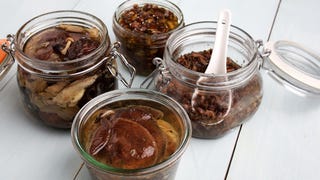Most people on the long weekends are down for firing up the ol' BBQ and throwing on some meat to grill, but John Thomson takes his barbecuing a lot more seriously. When he's not working as an IT professional, he's
competing in BBQ competitions, as well as teaching people about the
finer points of BBQ cooking. I had a chance to ask him some questions via e-mail recently, and here's what he had to say.
FRANKLIN on FOOD: What's the difference between the barbecuing you do, and the steak and burgers I'm cooking on my grill?
JOHN THOMSON: What Canadians typically call "BBQ" is actually more commonly known as "grilling". This is the technique of cooking hot and fast, alternating between direct and indirect cooking. It's what most of us started doing, and usually on a propane gas grill.
What we do is more traditional BBQ. That is, low, slow and usually cooking indirectly, often in a smoker with temperatures ranging from 200 - 250 degrees F. For instance, a pork butt we might cook for 12 - 18 hours in order to get the fat and connective tissue to render down and resulting in soft, juicy and flavourful meat.
Both are legitimate and popular cooking techniques. Some BBQ competitions actually have a grilling contests too.
FoF: Is what's cooked at RibFest true BBQ?
JT: That's a great question. The quick answer is, "Yes, it often is". Now, it may not be low and slow for 6 hours or more, that just isn't practical given the volume of food those vendors have to turn out at a Ribfest. But most is cooked on big commercial smokers, slathered in sauce and they make plenty of it.
FoF: How did you get interested in this style of cooking?
JT: I started with a pellet smoker, after my buddy bought one and cooked a prime rib and some bacon-wrapped, cheese-filled jalapeños. I was hooked right there and then. You just cannot beat the taste, the textures, and the smells from a long and slow cook. And bacon? Come on...
I bought mine and immediately started figuring out ribs. You see, I once boiled ribs based on the advice of my Dad. I couldn't eat them, I was so grossed out by the brown and gray foam in the pot. But when I got my pellet cooker, I worked on ribs for a good year before being pleased. I entered and won my first BBQ Competition with those ribs, and 8 years later, I still cook that same recipe, and I still win a fair amount with those ribs.
FoF: Do you think BBQ gets its due as a way of cooking?
JT: I think that, in Canada, it is starting to gain respect as a true form of cuisine, and not just something that happens on the back deck with a beer in hand (not that there's anything wrong with that!) for 2 months of the year. With more BBQ supply stores opening or growing like Capital BBQ and several new BBQ restaurants opening, I would say that this is reflective of an industry that is really growing in Canada. It helps having a good selection of quality BBQ restaurants, as this is how most of the public is introduced to this style in the first place.
FoF: Gas or charcoal, what's the better grill?
JT: Gas is fast, easy and hot. That's why most people are drawn to it. Sadly, many don't realize that charcoal is easy to use and the results are inarguable better. Using a good quality charcoal, it is incredibly easy to build and maintain a cooking area that is perfectly suited for the dish. Throw in a chunk of wood like hickory, cherry,maple....and the results are even better.
I do not own a gas grill. I can get my Kamado style ceramic cooker, blazing hot in minutes. Or I can maintain a low heat in order to add some some flavours.
All that to say: Charcoal is better, in my opinion.
But there are other options we shouldn't discount, such as a pellet cooker that works with a digital controller where you set the target temperature and let technology do all the work for you. A great entry-level cooker, and an easy way to make great foods.
FoF: What's a good starting meat for beginner BBQers?
JT: When starting out, and learning your cooker, you will want to try a meat that is forgiving and not terribly expensive. Pulled pork is perfect for this. Using the right cut of pork, the "pork butt" (a part of the shoulder, named after the barrels or butts, they were shipped in, not an anatomical reference.), all a new cook has to really do is make sure they cook it to an internal temperature in the 190 - 200 degrees F range and that's it. This allows cooks to experiment with flavours, temperatures and rubs without worrying too much about perfect the meat itself. After that, people tend to drift towards ribs and then they have their eyes on beef brisket. But, I like to advise people to walk, then run. Learn your cooker, get comfortable and above all: HAVE FUN.
FoF: What's the number one mistake people make when BBQing?
JT: Cooking too fast, with too much heat. Many people are surprised by how much cooking power you can get out of a small amount of charcoal, so they tend to fill their charcoal bowls, get it fired up and then burn their foods up. A little goes a long way!
FoF: There are various
American regional styles of BBQ, are there any Canadian regional styles that you're aware of?
JT: Most Canadians are drawn to the sweet and sticky BBQ which is very common in the Kansas City region. But we are starting to see a rise in Texas BBQ coming to Canada, at places such as
Adamsons in Toronto or
Meatings in Ottawa. Food that is cooked with a minimal of complex flavoured rubs, and often without sauce on the meat. This allows the flavours of the smoke, the wood, the meats to all come together for an incredible experience. I am very happy to see this style on the rise up here.
FoF: Is there a BBQ style that you prefer, and why?
JT: I like it all. Sweet, spicy, mustard, tangy. I just don't much care for vinegar sauces. I've never had a pallet for vinegar, so that North Carolina style kind of throws me off a bit. But otherwise, bring it on!
FoF: If you're not cooking it, where's a good BBQ place in Ottawa, and what do you order?
JT: There are a few great spots in town, we are very lucky in Ottawa these days! Out West I like to visit
Red Shack BBQ on Carp Rd. It's exactly what it sounds like: A little red shack with big BBQ flavours. In the Market area,
Fatboys Southern Smokehouse is a fun and vibrant place with a wide variety of unique takes on some standard fare. In the east, you can not beat the newcomers at Meatings. They operated a BBQ catering business in Ottawa for 5 years before opening this restaurant. It's a cozy spot in Orleans and their brisket (ordered "fatty" for more flavour) and ribs are unparalleled in Ottawa.
FoF: How did you go from grilling for trophies to teaching at
Canada's BBQ School?
JT: I have been teaching BBQ Clinics at
Capital BBQ for about a year now, and while that allows me to teach backyarders of all walks. It's a ton of fun. But the BBQ Classes that I offer through BBQClass.ca is more aimed at people who are considering entering the world of Competition BBQ, or existing teams looking to up their games, or anyone who wants a taste of a different aspect of BBQing.
FoF: How many hours go into planning all the details when someone enters a BBQ tournament?
JT: All of them. LOL! As a cook, I plan and plan. I make lists and then lists of lists. I Practice, I test, I tune and I record everything. But that's me. For anyone new thinking of entering a contest (such as the Capital BBQ Festival being held this Aug 4 - 6 at the Carp Fairgrounds), there are a great amount of resources available to them, to help get started. First off, I would point them to the
Canadian BBQ Society, a non-profit organization who organizes all of the Teams, Judges and Organizers in Canada and promotes BBQ Competitions from coast to coast. They have a very active Facebook chat page as well as packing lists and advice of all kinds for anyone considering this.
Additionally, becoming a "Certified BBQ Judge" is a great way to learn what the judges are looking for when you serve your dishes. Many cooks are also judges for this reason. There is a Certified BBQ Judge Class being offered on August 4th at the
Capital BBQ Festival.
FoF: What will be some of the highlights at this year's festival?
JT: With demos, bands, vendors and a beer garden, this event is unlike anything Ottawa has ever seen before. We have a HUGE focus on engaging the General Public at this event. 3 of our events are actually judged by the general public! Friday from 6 - 7 PM is our People's Choice Chicken Wing Contest. 25 Pro BBQ Teams will be cooking up Wings for the public to sample, and then they text their votes to help us determine the winners. Saturday we are hosting a Charity Ribfest where we sell Judges Seats and the teams are cooking their best BBQ ribs for the judges to sample and vote on. Sunday from 2 - 3 PM is our People's Choice Pulled Pork Contest. Same idea but this time the public gets to sample authentic competition grade pulled pork!
All funds raised from these events will be directed to our charities.





















